Aida | Opera Australia
Written by Adrienne Gross |
Thursday, 23 July 2009
|
 |
Above - Michael Lewis (Amonasro) & Tamara Wilson (Aida) kneel before David Parkin (The King).
Photos - Branco Gaica
Opera Australia’s production of
Aida is like a beautiful porcelain doll: fun to dress up in pretty dresses, but without the ability to talk. The sumptuous costumes, dynamic set design and effective lighting bring zazzle to technically perfect performers, but the acting and character believability was lacking. Overall
Giuseppe Verdi’s Aida is one of those operas to see in one’s lifetime, and with this production, you’ll go home impressed with the cleverness - but you probably won’t shed a tear at the end.
Set in the time of the pharaohs,
Aida has four acts over three hours and is one of the grandest Italian-language operas to fill stages worldwide since its premiere in 1871. As with any melodrama, there are love triangles, family feuds, warring nations and a tragic heroine woven into plot twists and turns. The first act opens with warrior wannabe
Ramadès being granted his wish to lead the Egyptian army against Ethiopia. Meanwhile, the Egyptian princess
Amneris pines for
Ramadès, and suspects a rival female attention - later confirmed to be her slave, the captive Ethiopian princess,
Aida. After winning the battle, the
pharaoh promises
Ramadès anything he wants. The story continues with betrayal, dilemmas and the tragic finale.
Overall,
Aida is a bit like the most un-politically correct dinner party you can have: where sex, politics and religion are spread out on the table as an audience feast. Indeed, the direction by
Graeme Murphy gave the effect that we were the gods, watching the humans create a mess of their lives.
And what a mess - imagine you had to choose between the love of your country and your lover. No wonder
Verdi littered the songs with such extreme words as ‘let death be their just destination’ and ‘helpless children slain.’ That level of emotion means expectations are high for some tormented stage presence so powerful that the visceral pain of the character should be spilled into voice and physicality. This is the basis of empathy, a bridge between audience and actor, without which one may as well be watching the midday movie with some Tim Tams. Thus, I was a little disappointed at the disconnection been the performers and their roles. There is no doubting the technical skill of the voices - pure and controlled - but the interaction between characters was like individuals who happened to be on stage with someone else. There are many reasons why this lacking in emotional dialogue exists: mis-casting, minimalist direction, even the plot itself.
However, each performer still gave competent individuality to their roles.
Amneris, as played by
Milijana Nikolic was the standout, embracing the pharaoh’s daughter role with panache; exuding richness, haughtiness and class.
Aida (
Tamara Wilson) came across as a lost little girl, quivering with indecision at her fate.
Dongwon Shin’s Ramadès held himself grandly and hit the long notes without fault. The supporting characters of
High Priest (
Jud Arthur) and
King of Egypt (
David Parkin) performed to their roles with sternness, with
Michael Lewis popping with verve as the impassioned patriotic King of Ethiopia
Amonasro, who wanted to win at any price. Perhaps that embodiment of emotion is what the other characters needed, in the way they walked, stood and gestured.
Between all the main characters were the dancers and the chorus of men and women. The dancers made for delightful jumpstarts, popping around the stage with grace and clever choreography. The chorus was in tune and provided a background humming of either doom or elation as plot required. Some of the stage action though seemed bit unpolished, as movements weren’t quite so in-time and symmetrical as was most likely intended.
If this production of
Aida were a film, surely the Oscar would go to creative associate
Janet Vernon and the set designer
Roger Kirk, the latter also designing the magnificent costumes. Their combined talents transformed the small stage into a spectacular arrangement of simple and effective scene transitions and dynamic movement. The lighting design by
Damien Cooper and projection design by
The Brothers Gruchy were also outstanding in creating mood and shifting scenes from desert to lush valleys. I won’t spoil the surprises, but I looked forward to each new scene to see what masterful idea they brought into what is already renowned for being a grand-scale opera.
The grandness was also conducted by
Sir Richard Armstrong via the tight and technical performance of the
Australian Opera and Ballet Orchestra, particularly the brass section. The music of
Aida isn’t as widespread in
Looney Tunes and advertising as is say, the
Barber of Seville, but many people would know the
Triumphal March. No wonder it’s used at soccer games to celebrate victory - this was the musical climax, with all the performers arranged on stage pooling their voices together in a shaking tremor of glory. Contrasting to the gusto of machismo was the hum-along delicate
Possente Fthà, as sung by the maidens of
Amneris’ court.
All of the performers were first rate - but as a whole, the cast was a fizzle without the pop.
Aida is worth seeing though for the complete theatrical experience: lavish costumes, clever set design and crafted orchestral performance.
Opera Australia presents
Aida
by Giuseppe VerdiVenue: Opera Theatre, Sydney Opera House | Bennelong Point, Sydney
Dates: 15 Jul - 15 Sep 2009
Tickets: $93 - $250


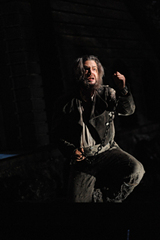 Most of the hype for Opera Australia's Winter Season has focused on the obvious headliners: Graeme Murphy's splashy new Aida, for instance, and a long run of The Mikado starring homegrown heartthrob Anthony Warlow. Amidst all that buzz one might be forgiven for overlooking or underestimating the company's revival of Beethoven's Fidelio, especially after the withdrawal of star soprano Lisa Gasteen, who was to sing the title role. Yet this Fidelio proves that you don't need a new staging, ubiquitous banner ads or even a superstar diva in the lead to create a hit show.
Most of the hype for Opera Australia's Winter Season has focused on the obvious headliners: Graeme Murphy's splashy new Aida, for instance, and a long run of The Mikado starring homegrown heartthrob Anthony Warlow. Amidst all that buzz one might be forgiven for overlooking or underestimating the company's revival of Beethoven's Fidelio, especially after the withdrawal of star soprano Lisa Gasteen, who was to sing the title role. Yet this Fidelio proves that you don't need a new staging, ubiquitous banner ads or even a superstar diva in the lead to create a hit show. 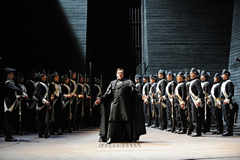 Stellar singing in this production is not limited to this powerful trio. Lorina Gore is a superlative Marzelline, her sparkling soprano slicing deftly through the densest of Beethoven's orchestration without losing its sweetness. Marzelline could easily come across as silly or saccharine, but Gore imbues her instead with real pluck and a trace of dignity, and her radiant presence stands out in the first act's sublime quartet. Stephen Smith is equally impressive as the smitten porter, Jaquino, matching light, graceful singing to an irresistible stage presence. As a 2009 Young Artist, Smith has succeeded in a number of smallish roles this season, but his excellent Jaquino is easily the best of them. Conal Coad brings his characteristic mix of wit, warmth and sonorous, stylish singing to Rocco, the flawed but goodhearted jailer, while Warwick Fyfe is striking in his brief appearance as Don Fernando, the Minister of State, singing with solid authority and looking eerily like Napoleon. There's a typically strong showing from the chorus as well, particularly its men, who sing with soft, transcendent voice in the opera's justly famous Prisoners' Chorus.
Stellar singing in this production is not limited to this powerful trio. Lorina Gore is a superlative Marzelline, her sparkling soprano slicing deftly through the densest of Beethoven's orchestration without losing its sweetness. Marzelline could easily come across as silly or saccharine, but Gore imbues her instead with real pluck and a trace of dignity, and her radiant presence stands out in the first act's sublime quartet. Stephen Smith is equally impressive as the smitten porter, Jaquino, matching light, graceful singing to an irresistible stage presence. As a 2009 Young Artist, Smith has succeeded in a number of smallish roles this season, but his excellent Jaquino is easily the best of them. Conal Coad brings his characteristic mix of wit, warmth and sonorous, stylish singing to Rocco, the flawed but goodhearted jailer, while Warwick Fyfe is striking in his brief appearance as Don Fernando, the Minister of State, singing with solid authority and looking eerily like Napoleon. There's a typically strong showing from the chorus as well, particularly its men, who sing with soft, transcendent voice in the opera's justly famous Prisoners' Chorus. 










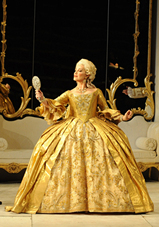 Puccini was not the first composer, nor even the second, to turn the Abbé Prevost's L'histoire du chevalier des Grieux et de Manon Lescaut into an opera. Both Auber and Massenet had already tackled the subject. None of the three adhered too rigidly to the original, which was probably a smart move given the style of its narrative: a sentimental, intermittently moralistic flashback told entirely by the miserable Des Grieux, in which Manon is barely allowed to speak, let alone develop a personality of her own beyond her spectacular selfishness and fatal beauty. Puccini's Manon isn't any more admirable than her literary counterpart, but at least she's three-dimensional.
Puccini was not the first composer, nor even the second, to turn the Abbé Prevost's L'histoire du chevalier des Grieux et de Manon Lescaut into an opera. Both Auber and Massenet had already tackled the subject. None of the three adhered too rigidly to the original, which was probably a smart move given the style of its narrative: a sentimental, intermittently moralistic flashback told entirely by the miserable Des Grieux, in which Manon is barely allowed to speak, let alone develop a personality of her own beyond her spectacular selfishness and fatal beauty. Puccini's Manon isn't any more admirable than her literary counterpart, but at least she's three-dimensional. 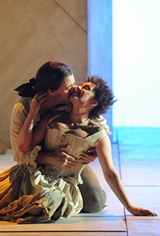 Among the supporting cast, tenor Stephen Smith is most impressive, as a lithe and energetic Edmondo. Dominica Matthews's rich contralto is a luxury in the Madrigal Singer's brief appearance, as is tenor Andrew Brunsdon's turn as the Lamplighter. Graeme Macfarlane, master of the effete character role, is ideal in his cameo as Manon's fussy Dancing Master. The chorus is in fine form, with the women especially revelling in the campy possibilities of their roles as French prostitutes.
Among the supporting cast, tenor Stephen Smith is most impressive, as a lithe and energetic Edmondo. Dominica Matthews's rich contralto is a luxury in the Madrigal Singer's brief appearance, as is tenor Andrew Brunsdon's turn as the Lamplighter. Graeme Macfarlane, master of the effete character role, is ideal in his cameo as Manon's fussy Dancing Master. The chorus is in fine form, with the women especially revelling in the campy possibilities of their roles as French prostitutes. 

 Fidelio is a dark, dour work. We are drawn into the murky shadows, squinting almost to make out the politically persecuted left to rot in their underground hell. Florestan is on death row; his executioner, prison governor Don Pizarro, holds a vengeful grudge against the man for exposing his crimes.
Fidelio is a dark, dour work. We are drawn into the murky shadows, squinting almost to make out the politically persecuted left to rot in their underground hell. Florestan is on death row; his executioner, prison governor Don Pizarro, holds a vengeful grudge against the man for exposing his crimes.
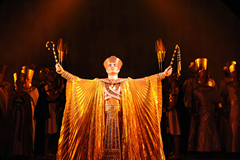 Among the four principal singers, only two start as they mean to continue. From her first note to her last, Tamara Wilson's Aida displays a voice of distinctive beauty and apparently effortless power, warm and evenly produced throughout her considerable range. While not a natural actress, she is a sincere and sympathetic heroine. As her father, Amonasro, Michael Lewis is likewise excellent from his first appearance, his commanding voice and presence carrying all the hallmarks of a first rate Verdi baritone. Dongwon Shin copes well with Radames' demanding "Celeste Aida," but not until his third act assignation with Aida does the thrilling power of his voice properly reveal itself. His muscular tenor blends effectively with Wilson's tender soprano in their shimmering final duet. Milijana Nikolic, as a feline Amneris, also takes time to warm up, but her earthy contralto flares up in the final act with a blistering depiction of the princess's inner torment.
Among the four principal singers, only two start as they mean to continue. From her first note to her last, Tamara Wilson's Aida displays a voice of distinctive beauty and apparently effortless power, warm and evenly produced throughout her considerable range. While not a natural actress, she is a sincere and sympathetic heroine. As her father, Amonasro, Michael Lewis is likewise excellent from his first appearance, his commanding voice and presence carrying all the hallmarks of a first rate Verdi baritone. Dongwon Shin copes well with Radames' demanding "Celeste Aida," but not until his third act assignation with Aida does the thrilling power of his voice properly reveal itself. His muscular tenor blends effectively with Wilson's tender soprano in their shimmering final duet. Milijana Nikolic, as a feline Amneris, also takes time to warm up, but her earthy contralto flares up in the final act with a blistering depiction of the princess's inner torment.